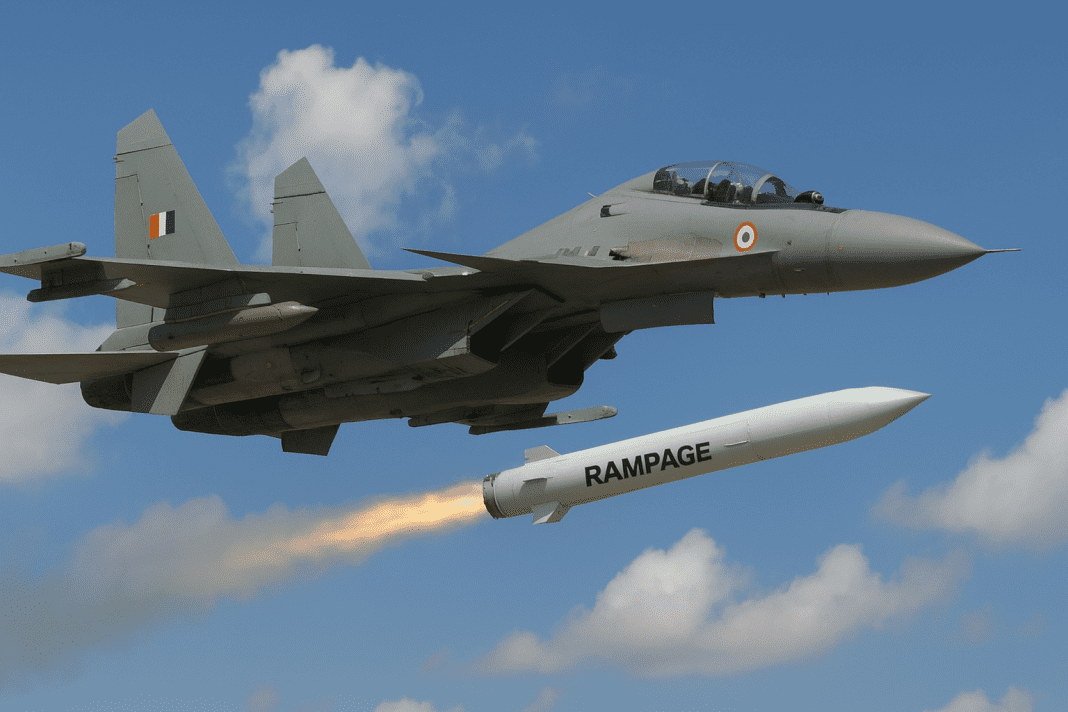The Indian Air Force (IAF) is moving ahead with a major decision to procure a large number of Rampage missiles from Israel. These advanced weapons gained attention during Operation Sindoor. They were extensively fired from Su-30 MKI fighter jets. The strikes targeted Pakistani positions located deep inside their territory. The strikes showed how effective the Rampage missile could be in modern warfare.
Rampage Missile Adds New Edge to IAF Firepower
The Rampage missile, also known as an air-to-surface precision strike weapon, hits long-range ground targets with great accuracy. Israel originally developed the weapon, and the IAF has already placed it in limited service. The IAF used it in critical missions and demonstrated its capability, which pushed the plan for a much larger induction.
The IAF first purchased a batch of Rampage missiles around 2020–21, shortly after the Galwan clashes. Since then, the force has tested the system in multiple operations and proved its reliability and performance in real combat conditions. During Operation Sindoor, the missile played a major role and gained greater prominence, as it struck key targets while being launched from safe distances.
Surveillance Threat: China’s Deadly Radar Tracks Every Indian Missile from 5,000 km Away
Successful Strikes with Rampage Missile on Su-30 MKIs
Reports indicate that the IAF successfully deployed the Rampage missile against terrorist headquarters and air bases inside Pakistan, particularly in areas such as Muridke and Bahawalpur in Punjab province. These strikes demonstrated the missile’s “remarkable precision,” as it hit targets that conventional weapons found difficult to destroy.
The IAF has currently integrated the Rampage missile with the Russian-origin Su-30 MKI fighter jets, which form the backbone of its fleet. By carrying these missiles, the Su-30 MKIs now have a new edge in long-range strike missions. Along with the Rampage, these jets are also capable of deploying the BrahMos supersonic cruise missile, which can strike targets over 400 kilometers away. This combination of weapons significantly boosts the strike power of the aircraft.
Indian Army shares 1971 report on $2 billion U.S. arms to Pakistan amid oil trade row
During Operation Sindoor, the Su-30 MKIs fired multiple Rampage missiles, delivering heavy blows to Pakistani military positions. This operation displayed not just the range of the missile but also its ability to penetrate deep into hostile territory. Such precision strikes allowed the IAF to achieve its objectives without risking aircraft or pilots in enemy airspace.
The missile has been designed to evade detection and intercept systems, making it harder for enemy defenses to stop. This makes the Rampage missile highly effective against fortified installations, command centers, and runways. The system’s performance during the strikes confirmed its value, and that is why the IAF is now planning to deploy it more widely.
Fast-Track Procurement and Local Production Plans
According to reports, the IAF has moved the procurement under fast-track procedures to ensure the missiles are acquired quickly. Contracts for this deal are expected to be finalized soon. This shows the urgency with which the air force wants to strengthen its strike capabilities using this proven system.
Another important development is that discussions are underway to manufacture the Rampage missile in India under the Make in India programme. If this happens, it could pave the way for large-scale domestic production. Local manufacturing would allow the IAF to build a steady supply of these missiles without depending completely on imports.
In parallel with the Rampage missile, the IAF has also been testing other advanced systems to diversify its arsenal. Last year, the force carried out tests of the Israeli ROCKS missile, also known as Crystal Maze-2, in the Andaman and Nicobar Islands. This was part of its larger plan to modernize precision strike capabilities.
🛡️ India quietly tests ULPGM-V3 missile that could shift South Asian power dynamics
The focus on high-precision long-range missiles shows how modern air forces are adapting to new challenges. Weapons like the Rampage missile allow aircraft to stay at a safe distance while still hitting critical targets accurately. The IAF’s experience during Operation Sindoor gave a real-time demonstration of this advantage.
The IAF is moving towards a bigger procurement of the Rampage missile to equip its fighter jets with some of the most advanced strike weapons available. The force is also exploring the possibility of Make in India production, which will increase the system’s importance within the Indian arsenal.

